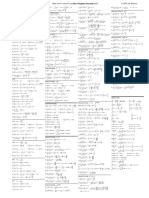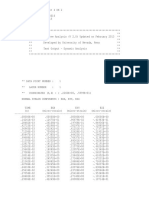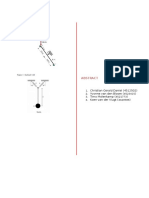0 ratings0% found this document useful (0 votes)
306 viewsXHXHXH
XHXHXH
Uploaded by
Christian Gerald Danielbhxhxh
Copyright:
© All Rights Reserved
Available Formats
Download as DOCX, PDF or read online from Scribd
XHXHXH
XHXHXH
Uploaded by
Christian Gerald Daniel0 ratings0% found this document useful (0 votes)
306 views8 pagesbhxhxh
Original Title
xhxhxh
Copyright
© © All Rights Reserved
Available Formats
DOCX, PDF or read online from Scribd
Share this document
Did you find this document useful?
Is this content inappropriate?
bhxhxh
Copyright:
© All Rights Reserved
Available Formats
Download as DOCX, PDF or read online from Scribd
Download as docx or pdf
0 ratings0% found this document useful (0 votes)
306 views8 pagesXHXHXH
XHXHXH
Uploaded by
Christian Gerald Danielbhxhxh
Copyright:
© All Rights Reserved
Available Formats
Download as DOCX, PDF or read online from Scribd
Download as docx or pdf
You are on page 1of 8
Example 10
A porttensioned beam hes a 35 m apsn, see figure 10.1. The beam ha: a rectangular cro
Section; width 5 = 0,75 m and height t= 1,8 m. The beam is prestressed using curved tendons
(Gtrand: in ducts). The fictitious tendon profile consists of two parabolas, namely parabola 1 with a
radius of curvature 2, =.62 m over, = 10 mand parabola 2 with R,=330mover4 =25 m
‘Tue bowom of both parsbolas is st position A (they joint at this position) in Figure 3.1, which is at
4, = 10 mm from the left support The bottem of the parabola: te at 0,2 m fom the Bottom fiber of
the beam.
Figure 10.1 Side view of the girder including fictitious tendon prodile (not to scale).
Parameters:
Density concrete spo 25 Nia?
‘Varuble load Ogg #10 KN
Strength class of concrete 50160
‘Strength class of prestessing steel vyiseos?
Elastic modulus presreesing steel 22, = 195000 Nam?
‘Question 10.1
‘Calculate the tendon eccentricities relative o the centoidal axis at the twe anchors
Auswer 10.1
=> 806 +200 - 900 = 106mm
5047 + 200- 800= 247 mm
‘Question 10.2
‘Show iu a figure all the loads on the beam fiom a prestressing force P, assuming that there is no
‘fiction and no wedge set
Auswer 10.2
‘Question 10.3
Calculate and draw the bending moment diagram resulting from a prestrassing force P. Assume
that there is no friction and no-wedge set
Auswer 16.3
1: From anchor eccemicitigs:
2: Uniformly distributed load
4 4: contbation left after epplving @:
Total= 1-2-3:
‘Midspan (unite: mm):
(M — 3(176,5 -464,0-327,5) —-615F
aac:
ca a:
)
woolen Jeleabcs bales B
7)
i, 10
en {ios- 18 (106-24
lop
Tso.
10-16 (35-10' = 10-10")
re P
(62-10 330-10"
(2M —P(145,3-378.8-467.8)
‘unit [mm]
You might also like
- The Subtle Art of Not Giving a F*ck: A Counterintuitive Approach to Living a Good LifeFrom EverandThe Subtle Art of Not Giving a F*ck: A Counterintuitive Approach to Living a Good LifeRating: 4 out of 5 stars4/5 (5943)
- The Gifts of Imperfection: Let Go of Who You Think You're Supposed to Be and Embrace Who You AreFrom EverandThe Gifts of Imperfection: Let Go of Who You Think You're Supposed to Be and Embrace Who You AreRating: 4 out of 5 stars4/5 (1108)
- Never Split the Difference: Negotiating As If Your Life Depended On ItFrom EverandNever Split the Difference: Negotiating As If Your Life Depended On ItRating: 4.5 out of 5 stars4.5/5 (888)
- Hidden Figures: The American Dream and the Untold Story of the Black Women Mathematicians Who Helped Win the Space RaceFrom EverandHidden Figures: The American Dream and the Untold Story of the Black Women Mathematicians Who Helped Win the Space RaceRating: 4 out of 5 stars4/5 (926)
- Grit: The Power of Passion and PerseveranceFrom EverandGrit: The Power of Passion and PerseveranceRating: 4 out of 5 stars4/5 (598)
- Shoe Dog: A Memoir by the Creator of NikeFrom EverandShoe Dog: A Memoir by the Creator of NikeRating: 4.5 out of 5 stars4.5/5 (545)
- The Hard Thing About Hard Things: Building a Business When There Are No Easy AnswersFrom EverandThe Hard Thing About Hard Things: Building a Business When There Are No Easy AnswersRating: 4.5 out of 5 stars4.5/5 (354)
- Elon Musk: Tesla, SpaceX, and the Quest for a Fantastic FutureFrom EverandElon Musk: Tesla, SpaceX, and the Quest for a Fantastic FutureRating: 4.5 out of 5 stars4.5/5 (476)
- Her Body and Other Parties: StoriesFrom EverandHer Body and Other Parties: StoriesRating: 4 out of 5 stars4/5 (831)
- The Emperor of All Maladies: A Biography of CancerFrom EverandThe Emperor of All Maladies: A Biography of CancerRating: 4.5 out of 5 stars4.5/5 (274)
- The Little Book of Hygge: Danish Secrets to Happy LivingFrom EverandThe Little Book of Hygge: Danish Secrets to Happy LivingRating: 3.5 out of 5 stars3.5/5 (419)
- The World Is Flat 3.0: A Brief History of the Twenty-first CenturyFrom EverandThe World Is Flat 3.0: A Brief History of the Twenty-first CenturyRating: 3.5 out of 5 stars3.5/5 (2272)
- The Yellow House: A Memoir (2019 National Book Award Winner)From EverandThe Yellow House: A Memoir (2019 National Book Award Winner)Rating: 4 out of 5 stars4/5 (99)
- Devil in the Grove: Thurgood Marshall, the Groveland Boys, and the Dawn of a New AmericaFrom EverandDevil in the Grove: Thurgood Marshall, the Groveland Boys, and the Dawn of a New AmericaRating: 4.5 out of 5 stars4.5/5 (270)
- The Sympathizer: A Novel (Pulitzer Prize for Fiction)From EverandThe Sympathizer: A Novel (Pulitzer Prize for Fiction)Rating: 4.5 out of 5 stars4.5/5 (122)
- Team of Rivals: The Political Genius of Abraham LincolnFrom EverandTeam of Rivals: The Political Genius of Abraham LincolnRating: 4.5 out of 5 stars4.5/5 (235)
- A Heartbreaking Work Of Staggering Genius: A Memoir Based on a True StoryFrom EverandA Heartbreaking Work Of Staggering Genius: A Memoir Based on a True StoryRating: 3.5 out of 5 stars3.5/5 (232)
- On Fire: The (Burning) Case for a Green New DealFrom EverandOn Fire: The (Burning) Case for a Green New DealRating: 4 out of 5 stars4/5 (75)
- The Unwinding: An Inner History of the New AmericaFrom EverandThe Unwinding: An Inner History of the New AmericaRating: 4 out of 5 stars4/5 (45)
- Single Page Integral TableDocument11 pagesSingle Page Integral TableChristian Gerald DanielNo ratings yet
- High and Low Temperature Performance of Crumb Rubber Modified BitumenDocument2 pagesHigh and Low Temperature Performance of Crumb Rubber Modified BitumenChristian Gerald DanielNo ratings yet
- Call For Paper & Poster: 2 International Conference On Indonesian Development (Icid 2019)Document1 pageCall For Paper & Poster: 2 International Conference On Indonesian Development (Icid 2019)Christian Gerald DanielNo ratings yet
- Form DOT F 1700.7Document267 pagesForm DOT F 1700.7Christian Gerald DanielNo ratings yet
- IntegralSummary PDFDocument1 pageIntegralSummary PDFSamuel CostaNo ratings yet
- Oceans - HillsongDocument3 pagesOceans - HillsongChristian Gerald Daniel100% (1)
- Assignment 4 OK 2 - NStrainDocument105 pagesAssignment 4 OK 2 - NStrainChristian Gerald DanielNo ratings yet
- CT - 2016Document36 pagesCT - 2016Christian Gerald DanielNo ratings yet
- DfgsgstsDocument1 pageDfgsgstsChristian Gerald DanielNo ratings yet
- Resources For Private Rental: Facebook GroupsDocument2 pagesResources For Private Rental: Facebook GroupsChristian Gerald DanielNo ratings yet
- DadadaDocument6 pagesDadadaChristian Gerald DanielNo ratings yet
- Step 1 Step 2 Step 3 Step 4 Step 5 Step 6: Pre Departure InformationDocument1 pageStep 1 Step 2 Step 3 Step 4 Step 5 Step 6: Pre Departure InformationChristian Gerald DanielNo ratings yet
- Lecture2 InterpolaticsdsonDocument43 pagesLecture2 InterpolaticsdsonChristian Gerald DanielNo ratings yet
- How To Enrol On Studielink: More Information About Using STUDIELINK Is Available Via: Select "I Have A Question"Document13 pagesHow To Enrol On Studielink: More Information About Using STUDIELINK Is Available Via: Select "I Have A Question"Christian Gerald DanielNo ratings yet
- Registration Checklist: DocumentsDocument1 pageRegistration Checklist: DocumentsChristian Gerald DanielNo ratings yet
- EACEF5: Paper#: 11 Abstract AcceptedDocument1 pageEACEF5: Paper#: 11 Abstract AcceptedChristian Gerald DanielNo ratings yet
- Daftar Nilai Test Ielts SimulationDocument6 pagesDaftar Nilai Test Ielts SimulationChristian Gerald DanielNo ratings yet
- IELTgggDocument1 pageIELTgggChristian Gerald DanielNo ratings yet
- Daftar Hasil Tes Potensi Akademik TANGGAL: 30 - 11 - 14 Instansi: Sps ItbDocument5 pagesDaftar Hasil Tes Potensi Akademik TANGGAL: 30 - 11 - 14 Instansi: Sps ItbChristian Gerald DanielNo ratings yet
- A. Pendahuluan: Lab. Mekanika TanahDocument2 pagesA. Pendahuluan: Lab. Mekanika TanahChristian Gerald DanielNo ratings yet
- Sinopsis FilmDocument3 pagesSinopsis FilmChristian Gerald DanielNo ratings yet
- Location Date Event Details Further InformationDocument2 pagesLocation Date Event Details Further InformationChristian Gerald DanielNo ratings yet
- DrumDocument1 pageDrumChristian Gerald Daniel0% (1)
- Kombinasi Antara Pengalaman, Kemampuan Diri, Serta SeniDocument5 pagesKombinasi Antara Pengalaman, Kemampuan Diri, Serta SeniChristian Gerald DanielNo ratings yet
































































